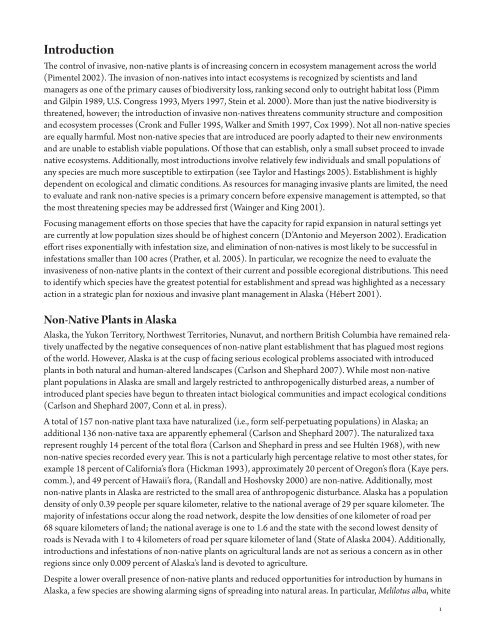Invasiveness Ranking System for Non-Native Plants of Alaska
Invasiveness Ranking System for Non-Native Plants of Alaska
Invasiveness Ranking System for Non-Native Plants of Alaska
You also want an ePaper? Increase the reach of your titles
YUMPU automatically turns print PDFs into web optimized ePapers that Google loves.
IntroductionThe control <strong>of</strong> invasive, non-native plants is <strong>of</strong> increasing concern in ecosystem management across the world(Pimentel 2002). The invasion <strong>of</strong> non-natives into intact ecosystems is recognized by scientists and landmanagers as one <strong>of</strong> the primary causes <strong>of</strong> biodiversity loss, ranking second only to outright habitat loss (Pimmand Gilpin 1989, U.S. Congress 1993, Myers 1997, Stein et al. 2000). More than just the native biodiversity isthreatened, however; the introduction <strong>of</strong> invasive non-natives threatens community structure and compositionand ecosystem processes (Cronk and Fuller 1995, Walker and Smith 1997, Cox 1999). Not all non-native speciesare equally harmful. Most non-native species that are introduced are poorly adapted to their new environmentsand are unable to establish viable populations. Of those that can establish, only a small subset proceed to invadenative ecosystems. Additionally, most introductions involve relatively few individuals and small populations <strong>of</strong>any species are much more susceptible to extirpation (see Taylor and Hastings 2005). Establishment is highlydependent on ecological and climatic conditions. As resources <strong>for</strong> managing invasive plants are limited, the needto evaluate and rank non-native species is a primary concern be<strong>for</strong>e expensive management is attempted, so thatthe most threatening species may be addressed first (Wainger and King 2001).Focusing management ef<strong>for</strong>ts on those species that have the capacity <strong>for</strong> rapid expansion in natural settings yetare currently at low population sizes should be <strong>of</strong> highest concern (D’Antonio and Meyerson 2002). Eradicationef<strong>for</strong>t rises exponentially with infestation size, and elimination <strong>of</strong> non-natives is most likely to be successful ininfestations smaller than 100 acres (Prather, et al. 2005). In particular, we recognize the need to evaluate theinvasiveness <strong>of</strong> non-native plants in the context <strong>of</strong> their current and possible ecoregional distributions. This needto identify which species have the greatest potential <strong>for</strong> establishment and spread was highlighted as a necessaryaction in a strategic plan <strong>for</strong> noxious and invasive plant management in <strong>Alaska</strong> (Hébert 2001).<strong>Non</strong>-<strong>Native</strong> <strong>Plants</strong> in <strong>Alaska</strong><strong>Alaska</strong>, the Yukon Territory, Northwest Territories, Nunavut, and northern British Columbia have remained relativelyunaffected by the negative consequences <strong>of</strong> non-native plant establishment that has plagued most regions<strong>of</strong> the world. However, <strong>Alaska</strong> is at the cusp <strong>of</strong> facing serious ecological problems associated with introducedplants in both natural and human-altered landscapes (Carlson and Shephard 2007). While most non-nativeplant populations in <strong>Alaska</strong> are small and largely restricted to anthropogenically disturbed areas, a number <strong>of</strong>introduced plant species have begun to threaten intact biological communities and impact ecological conditions(Carlson and Shephard 2007, Conn et al. in press).A total <strong>of</strong> 157 non-native plant taxa have naturalized (i.e., <strong>for</strong>m self-perpetuating populations) in <strong>Alaska</strong>; anadditional 136 non-native taxa are apparently ephemeral (Carlson and Shephard 2007). The naturalized taxarepresent roughly 14 percent <strong>of</strong> the total flora (Carlson and Shephard in press and see Hultén 1968), with newnon-native species recorded every year. This is not a particularly high percentage relative to most other states, <strong>for</strong>example 18 percent <strong>of</strong> Cali<strong>for</strong>nia’s flora (Hickman 1993), approximately 20 percent <strong>of</strong> Oregon’s flora (Kaye pers.comm.), and 49 percent <strong>of</strong> Hawaii’s flora, (Randall and Hoshovsky 2000) are non-native. Additionally, mostnon-native plants in <strong>Alaska</strong> are restricted to the small area <strong>of</strong> anthropogenic disturbance. <strong>Alaska</strong> has a populationdensity <strong>of</strong> only 0.39 people per square kilometer, relative to the national average <strong>of</strong> 29 per square kilometer. Themajority <strong>of</strong> infestations occur along the road network, despite the low densities <strong>of</strong> one kilometer <strong>of</strong> road per68 square kilometers <strong>of</strong> land; the national average is one to 1.6 and the state with the second lowest density <strong>of</strong>roads is Nevada with 1 to 4 kilometers <strong>of</strong> road per square kilometer <strong>of</strong> land (State <strong>of</strong> <strong>Alaska</strong> 2004). Additionally,introductions and infestations <strong>of</strong> non-native plants on agricultural lands are not as serious a concern as in otherregions since only 0.009 percent <strong>of</strong> <strong>Alaska</strong>’s land is devoted to agriculture.Despite a lower overall presence <strong>of</strong> non-native plants and reduced opportunities <strong>for</strong> introduction by humans in<strong>Alaska</strong>, a few species are showing alarming signs <strong>of</strong> spreading into natural areas. In particular, Melilotus alba, white1
















